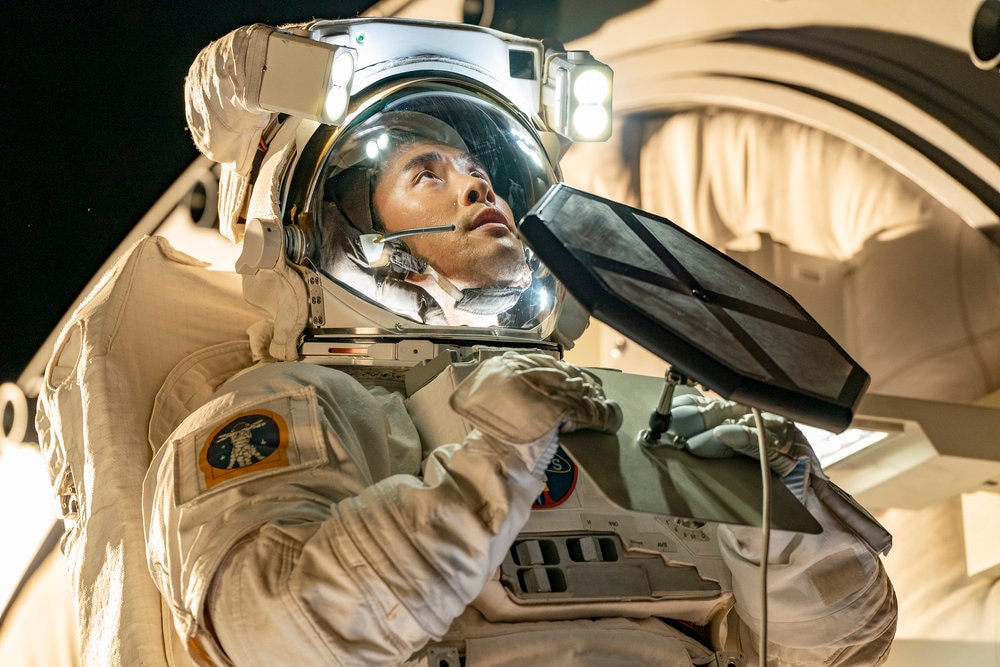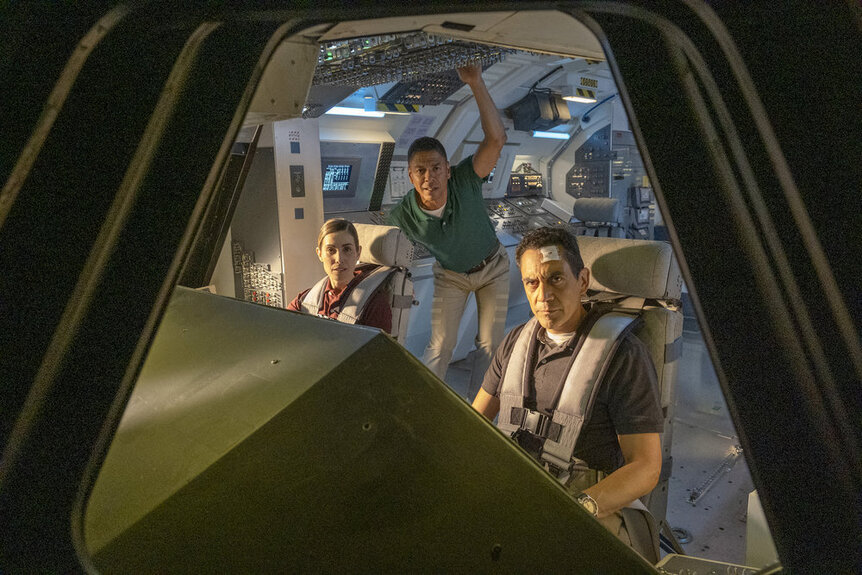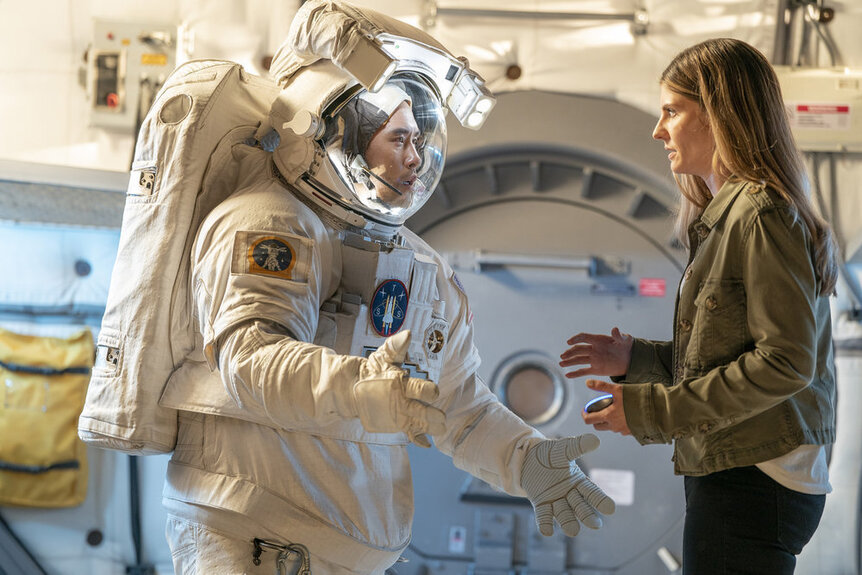Create a free profile to get unlimited access to exclusive videos, sweepstakes, and more!
What was real, and what was fiction, in 'Quantum Leap's Atlantis NASA mission
It's honestly a bit of both.

In 1989, Dr. Sam Beckett – played by Scott Bakula – began his travels through space and time in Quantum Leap. Each episode saw Beckett enter into the body of a different person at some seemingly random point in time and space. He maintained hope that the next jump would take him home. Sadly, it never did. Decades later, Dr. Ben Song – played by Raymond Lee – has picked up the mantle and leapt into the quantum continuum in NBC’s revival (which streams the next day on Peacock).
In the revival's second episode, “Atlantis,” Ben finds himself inside the body of astronaut David Tamura, aboard the Space Shuttle Atlantis, just seconds before it launches. Those familiar with the show know that Ben is tasked with changing some event, rewriting some moment in our history, in order to safely make the next jump and hopefully get home. In this case, that means preventing David Tamura from dying on a spacewalk when a cloud of debris crosses path with the shuttle. Of course, one change demands another and the piece of debris meant to end Tamura’s life damages the shuttle’s heat shielding and threatens the lives of the entire crew.
The Space Shuttle was the symbol of NASA’s commitment to a continued human presence in space after the conclusion of the Apollo program. It offered NASA a reusable spacecraft – four of them actually – and was crucial to the delivery and construction of the International Space Station. The program ended in July of 2011 when the shuttle Atlantis touched down for the last time. The program was largely a success, but it wasn’t without its failures. In fact, the narrative presented in Quantum Leap’s second episode sounds familiar to anyone with at least a passing knowledge of the shuttles’ history. But how accurate was it really?
MISSION AND ASTRONAUTS
In the episode’s opening moments, the Space Shuttle Atlantis lifts off and achieves low-Earth orbit. The date is March 7, 1998 and the mission is to deliver a module to the International Space Station. The crew is composed of Dr. Song (inside the body of David Tamura), Samantha Stratton, Commander Jim Reynolds, and Max.
We aren’t given a last name for Max, so his real-world analogue could have been any number of people, except that in more than half a century there has never been a single NASA astronaut named Max. In fact, none of the crew are based on real people. Each of them are inventions, which suggests that whichever reality Dr. Song leapt from, it isn’t ours.
Not only is the crew fabricated, the entire mission never happened. The Space Shuttle Atlantis is absolutely a real craft – it flew 33 missions and orbited the Earth nearly five thousand times before it was retired. Today, it lives at the Kennedy Space Center Visitor Complex in Florida – but it didn’t fly in March of 1998. In fact, it didn’t fly at all in 1998.
The timeline for ISS construction is more or less correct. The first module went up in November of 1998, not March, and it was delivered by Roscosmos in Russia, not NASA. The first U.S. contribution to the station went up just a couple of weeks later in early December of 1998. Atlantis wouldn’t get its hands on a part of the station until 2001 when it delivered the Destiny module.
SUITS AND SONGS
As the shuttle launches on the show, we see the crew donning orange launch and reentry suits. Affectionately called the “pumpkin suit,” they were the standard astronaut uniform for launch and reentry in 1998. There are actually two different suits which share the pumpkin suit name. The first is the Launch Entry Suit, or LES, which was used from 1988 to 1994. The second is the Advanced Crew Escape Suit, or ACES, which went into rotation in 1994 and was the default by 1998. If there were a mission on March 7 of that year, those are the suits astronauts would have worn. That’s one in the bag for Quantum Leap.
As soon as the crew hits microgravity, they hit play on a tape player and Frank Sinatra’s “Fly Me to the Moon.” Because there was no Shuttle mission in March of ‘98, there were no astronauts to play music, but this moment isn’t a complete fabrication. People have been playing music in space almost as long as we’ve been going to space. Ten days before Christmas 1965, astronauts Walter M. “Wally Schirra Jr. and Thomas P. Stafford, aboard Gemini 6, played a rendition of “Jingle Bells” with a harmonica and bells they smuggled aboard. They also reported a UFO which looked shockingly like Santa’s sleigh.
In the intervening years, astronauts have played music through stereos and with musical instruments countless times. Apollo 9 was the first to take cassette tapes into space. Apollo 13 astronauts played music from 2001: A Space Odyssey among other selections. And Commander Chris Hadfield made space travel and internet history when he recorded and released a music video cover of David Bowie’s “Space Oddity” from aboard the International Space Station.
Today, astronauts don’t have to rely on pre-recorded mixtapes, they can get new music whenever they want. It’s likely, then, that “Fly Me to the Moon” has been played in space more times that we’ll ever know, but there are a couple of times we do know about. The crew of Apollo 10, the last dress rehearsal before the famous first landing, look a tape which included “Fly Me to the Moon” on their trip, and it might have been played in space one more time, on the Moon’s surface.
Quincy Jones, who worked on the song alongside Sinatra and composer Bar Howard, was reportedly approached at a party by none other than Buzz Aldrin and told that when the astronaut was getting ready to step onto the lunar surface, he played the song.
PAYLOAD DOORS AND HEAT SHIELDING
In the episode, the trouble begins when something goes wrong in the cargo hold and the payload doors are jammed open. They’re leaking air and they need to get back to Earth or suffocate in space. Only, they can’t deorbit with the payload doors open. Closing the payload bay doors was a regular part of the deorbit process and generally occurred three hours before re-entry, according to NASA. While that portion of the craft didn’t come into direct contact with the atmosphere during re-entry, it would have been a bad idea to try and come home with the doors stuck in their open position. While no Space Shuttle ever encountered the doors stuck open, they did experience the opposite problem.
Shortly after reaching orbit, the Space Shuttle would open its payload bay doors to allow heat to radiate away. In 1996, Atlantis reached orbit and found itself unable to open the payload bay doors. With the temperature climbing, the flight director almost aborted the mission and brought the crew home. Luckily, the doors finally opened, allowing the craft and crew to continue their missions. It’s likely the writers of Quantum Leap took some inspiration from this real life event.
In the episode, Ben completes a spacewalk and jettison’s the ISS module, allowing the doors to close. In the process, the debris which was meant to kill him instead comes into contact with the shuttle and damages part of the heat shield. The damage is sufficient enough to destroy the shuttle and kill the entire crew if it isn’t repaired. This, too, was inspired by real world events.
In 2003, the Space Shuttle Columbia broke up in the atmosphere while attempting to return to Earth. The subsequent investigation revealed that a piece of foam fell away from the shuttle’s external tank and struck one of the wings, damaging the heat shielding. The hole in the shielding allowed intense heat to enter the wing during re-entry and ultimately destroyed the craft and killed the crew.
The events of Quantum Leap’s second episode have all the hallmarks of reality, just remixed into a series of events that never actually happened. Of course, maybe they did happen and Dr. Song simply changed them so we no longer remember.
Quantum Leap airs Mondays on NBC and streams the next day on Peacock.





























